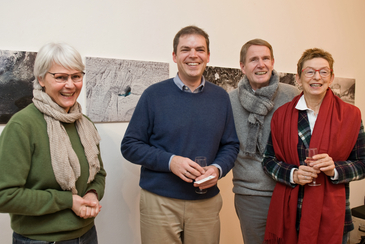One example is the Gorner Glacier, which is southeast of Zermatt in the Pennine Alps. Franziska Rutz has impressively alienated it by means of digital photography. Changes in the alpine world in her Swiss homeland are an important theme for the emotionally involved artist. “I used to be a member of the Swiss Alpine Club. We abseiled into crevasses. I was scared,” she says frankly. The artist has now lived in Brunswick, Germany, for almost 25 years. “I wanted to pick up on my childhood experiences and photograph the glaciers.” However, what she remembers as an unchanging alpine world is no longer the same. “The changes are noticeable – the ice is receding rapidly and holes have appeared.”
Slopes Starting to Slip
Scientist Ben Marzeion has placed a sobering diagram on the wall next to the artistic photomontage. It shows the temperature development at the Gorner Glacier and a suddenly falling curve, which represents its dimensions. “It’s already 2.5 kilometers shorter,” Marzeion explains. He tells the astonished listeners: “There are no glaciers in the Alps that are intact.” Glaciers had a life of their own. They accumulated snow from areas higher up. This then turned to ice and began to flow. “If the glacier loses its connection to the area where the snow accumulates, we call it dead ice.” It no longer moves and is usually covered with sediments. “With the current climate, the glaciers don’t have an accumulation area. It still looks like a glacier, but it isn’t one anymore.” The landscape around it also doesn’t stay as it was. “When the permafrost thaws, the slopes start to move because they no longer have any support.”
Climate Change and Questions of Values
For rising sea levels, melting glaciers are more important than melting ice sheets in the North and South Poles. What can science do? “We use objective methods to investigate developments in climate change and explain courses of action,” says the glaciologist. That’s all. Everything else is a question of values. “Everyone has to decide for themselves if they want to step on the gas on the highway in an SUV for 1,000 kilometers.” Marzeion is certain that the climate debate is suffering from the fact that these levels are being blurred.
When Art Goes Beyond Observation
Franziska Rutz talks about her art: “I go beyond observation into fantasy. What would it look like if mountains were to slide and holes were to form?” With his methodical approach, however, scientist Marzeion does not want to be blinded by sensory illusions. “The part I try to disregard in my research is the part that Franziska Rutz takes care of.” The Wissenschaft trifft Kunst (science meets art) event is well received by visitors to the gallery. For the University of Bremen it is a transfer contribution, because science is a part of society.

